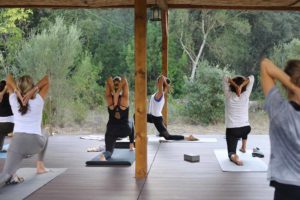

Exercise and Pilates on Holiday – Yes or No?!
When on holiday do you like to keep up your health and fitness routine or do you prefer to let it go and do nothing?!


As a Pilates Instructor, I have always favoured a more Clinical approach to the Pilates Method which is why I’ve enjoyed doing much of my training with the APPI Health Group (The Australian, Physiotherapy and Pilates Institute). This approach to Pilates teaching has evolved to complement Physiotherapy which helps to aid the recovery and rehabilitation of patients.
In 2011 I trained as an advanced Level 4 Pilates instructor specialising in working with clients with Low Back Pain. This has enabled me to receive referrals from health professionals including local Physiotherapists, Osteopaths, Chiropractors and GP’s and this is something I very much value and enjoy.
I would like to give Sarah Connors a special mention for her input with the blog. She is the most wonderful physiotherapist with 30 years’ experience and has worked for years alongside British Athletics (learn more about Sarah here).
I hope you enjoy the read…
Both Physiotherapy and Pilates have a main goal in mind which is to work together to enhance performance and reduce the risk of injury by strengthening weak muscles and improving mobility where it’s needed in the body.
Physiotherapy is about prevention as well as reducing the risk of injury in the future. It works to restore movement and function and will identify the tensions that result from heavy training. It has a holistic approach and likes to involve the patient in their own care and recovery. It tends to treat the body as a whole and not always the source of the pain and is keen on prevention.
A Physiotherapist will assess individuals and look at their joint mobility, function, and strength. It uses mobilisation and manipulation to restore optimal joint mobility with added soft tissue work to release tight muscles.
If you exercise a lot, and if you have been injured, suffered from joint pain and discomfort, then it’s likely that you have visited a physiotherapist for treatment. This is because it’s known to be a fantastic way of regaining and maintaining your physical health.
It’s your Physiotherapist who will assess, diagnose, and offer a treatment plan. Pilates instructors are not trained to do this part which is why it’s vital that you always get an injury looked at by a Physiotherapist, GP, or other Health Professional. They have the tools and training to find out what’s causing the problem and refer you to other specialists. You may find it likely that they recommend Pilates as a good exercise method to aid your road to recovery.
Physiotherapy has evolved and not only uses physical manipulation, but also understands the importance of movement in recovery and will prescribe exercises to assist. These exercises are often mat-based and do require a degree of strength and control. However, this does mean that it’s easy to perform them incorrectly and therefore they can sometimes not be as beneficial as they should be which is why a referral to a Pilates instructor is a great idea!
Rehabilitation exercises prescribed often incorporate components of Pilates movements…they might have just been given different names! Exercises such as imprinting, pelvic curls and shoulder bridges alongside various stretching Pilates movements such as the Cat Stretch are often used. This is because both methods focus on muscle balance, mobility and regaining full body strength whilst improving alignment, function, and body awareness.
You will normally start these exercises at a very low level with your physiotherapist who will most often advise a 1:1 session with a Pilates teacher first.
Something that Physiotherapy can offer that Pilates can’t… is the manual joint mobilisations and soft tissue release but the combination of this with exercises prescribed to do at home makes change possible. Manual therapy is vital for recovery and change. By removing physical restrictions better movement can be made possible, this helps the Pilates instructor to get to work on strengthening the weaker muscles without the restrictions and start work on mobilising and stretching tight areas in the body resulting in better outcomes.
You may not be aware of how effective Pilates can be for prehab, rehab, following injury or surgery when taught by a specialist Pilates Instructor and why the combination of both works so well together. It’s also why more physiotherapists are referring patients to Pilates and why many are also training in the Pilates Method themselves both in mat work and equipment-based Pilates. Both, often now work side by side to ensure successful outcomes for their clients.
The origins of Pilates are rooted in rehabilitation. Joseph Pilates the founder invented the Pilates Reformer to aid injured and sick people and worked with dancers as part of their rehabilitation from injury.
As mentioned above the programs prescribed by physiotherapists often use Pilates exercises to aid recovery as soon as possible. It’s so important to keep moving during recovery from injury and therefore Pilates is a great addition and partnership as it’s easy on the joints, is mindful of the injured areas and works on balancing the body and strengthening and mobilising where needed.
There has also been an increased awareness over the past few years of how important core strength and stability is for preventing injury, to help with performance and reduce pain. Pain in the body will switch off core muscles, which means they will lose muscle tone and strength very quickly…not great when it’s the time you need them the most! Injuries are often caused by muscle imbalances and poor posture which Pilates is always keen to address and this is especially true for back pain sufferers.
A Physiotherapist, GP or other Health Professional may recommend Pilates which can be done on a 1-1 basis, in a small Pilates class or by exercising on the Pilates equipment. It’s a good idea to follow the advice of your physiotherapist as to what would be the most beneficial.
The Pilates equipment is a great re-habilitation tool as the difficulty of the exercises can be easily adapted to suit the client and because it’s so important to move without pain and for the exercises to form part of a positive experience.
The equipment highlights poor movement patterns and muscle imbalances which are often the cause of injury. If we can all get our clients to improve their body awareness and posture and improve the way they move, it will prevent further injury and aid faster recovery.
Pilates is a great addition to an existing rehabilitation program and diagnosis, but it’s always very important to have your injury looked at and diagnosed first. Pilates must not replace the advice and recommendations made by your GP, Physiotherapist, or other health care provider, but it can make a great addition and impact on your recovery.
Specialised Pilates instructors and Physiotherapists can work together to achieve great outcomes for their clients. Together they can both educate and empower them to become part of their own recovery.
Both methods are a fantastic means of rehabilitation, but together they can be even better – making them such a great team!
Please follow Bridge Pilates to see what we are up to on Instagram and Facebook!


When on holiday do you like to keep up your health and fitness routine or do you prefer to let it go and do nothing?!


A retreat is not just a holiday it’s an experience!


Explore how Pilates can improve performance, prevent injury, and help you to cycle for longer!


It can be hard to stay on target with your health goals when life is busy and a challenge. Here are 6 top tips to help you stay motivated.


Mobility is key if we want to avoid injury, live independently, and stay active for as long as possible.
Get the latest news, and updates to new classes
All images and content
© Bridge Pilates Ltd 2023
Company number 13273672